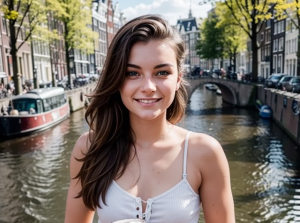Boosting Quality

Welcome back to Stable Diffusion basics. In this lesson, we will revisit the girl from the river in Lesson 2, and boost the quality further with embeddings.
PREREQUISITES
You should have created a fat cat and understand how to load a Model.
So to get the best looking image possible, we will introduce additional reinforcement using multiple kinds of models.
Lesson Goals
- Learn useful Quality-boosting positive and negative prompts
- Learn how to use Negative Inversions to boost quality further
Introduction to Negative Inversions
In Lesson 1 you learned that adding words like [[low quality]] produces higher quality images. Now, think about an entire small model helping you with that.
To use a gaming analogy, these are cheat codes. When you add negative models to your image, your results go from average to nearly perfect with very little prompting. This is why we’re encouraging you to learn this obscure idea early on.
Positive Prompt
A portrait of a beautiful 21 year old Swedish woman drinking a beer next to the river in Amsterdam
Negative Prompt
[[[<verybad-negative:-1.5><fast-negative:-1.5><bad-hands-v5:-1>]]]
Adding a negative model like “bad hands” will make hands look better, it is literally a model trained on cancelling out mangled hands. You can also add your own words like [big hairy nose] to suppress anything that you don’t want. We’ll explain what those specific “very bad” codes above mean in the advanced tutorials later.
Click render and you’ll be amazed at how much clearer the image is.
Negative Models and where to find them
To learn more about negatives, explore this tag in our models area. You can stack many negative models, just take notice of the special syntax above. The model is called inside a negative prompt, with a negative weight. If we don’t do this, it will boost the bad patterns, which would be bad.

Negative models have funny names, as a way to warn you about how to use them. Who would want to use a model called “Bad Artist? Oh right, that’s a negative.”
Placing [[<bad-artist-anime:-1.5>]] in the negative prompt box means “don’t give me bad artist results, by the power of 1.5x”. Powerful stuff.
But you wouldn’t use something called “artist” to make a realistic picture. The ones with more general-sounding names like [[<verybad-negative:-1.5>]] are recommended for realism.

A few favorite negatives, explained
[[<verybad-negative:-2>]] – a powerful, general purpose choice
[[<fast-negative:-2>]] – similar to the above, seems to compliment it
[[<negative-hands:-1.5>]] – it’s not perfect, but it seems to help hands
Put it all together

Glossary
Models (also known as checkpoints, loras, inversions, or concepts) are a blanket term for “AI Models”, that can produces a certain affect. Learn more about Models in Lesson 2.
Weights has a few definitions, but it most commonly means what percentage a model should impact the image. In our system, the maximum weight of a model is 2, while the total absence of a model is -2. The default weight is 0.7. Increasing or reducing the weight impacts how much influence the model has. When using multiple models, lowering each weight reduces the chance of conflicts. Reducing or Lowering weights is best way to troubleshoot models and reduce artifacts.
Textual Inversions aka Embeddings – Focused, small models that can be used together with other models, and the weights (or amount of influence) can be controlled. They have less “layers” so these are more commonly used for simple reinforcements. These files are tiny, so adding over ten of them is usually not a problem, as long as they are complimentary and not creating a push-and-pull effect. We jokingly have a recipe called #everythingbad that loads about 20 negative inversions, which will result in nice images! Try that in your next prompt.
Back to Web tutorials | Telegram tutorials
